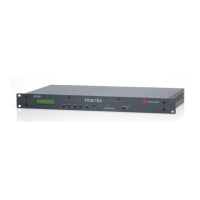T01LIA4,?
Query the command
associated with the active
state of logic pin 4.
T01LIA4,<string>, where
<string> is the command string that
will be executed when logic input 4 is
activated. If this query was given after
the example for logic input 4 above,
the response would be
T01LIA4,MUTEIT1.
8.44. LID -- Assign Action for when Logic Input is
Deactivated
This function assigns a single command to be executed when a given logic input changes from the
active state to the inactive state. Typically, the inactive state is logic high ('1') and the active state is
logic low ('0'). This is commonly referred to as active low. Acitve low is considered normal because a
closed switch would ground the input and a closed switch would normally be considered active. This
polarity setting can be changed via the
LIP command.
A single command can be assigned to each of three conditions occurring on the logic pin: a change to
the active state, a change to the inactive state, and a repeating command when the pin is held in the
active state. The LID command assigns a single command to the logic pin that is executed when the
logic pin changes to the inactive state.
Although only one command can be assigned to the state change, the command may be a
MACROX or
MACROQ command. Since up to 256 commands can be stored in each macro, this gives the effect of
having up to 256 commands execute when the logic pin changes state. The command associated with
the state change can also be a
PRESETX or PRESETQ. This makes it easy to reconfigure the device for
different rooms based on external logic settings.
The
BROADA is also useful in logic pin assignments. The BROADA command transmits a command to
another device on the EF Bus, so you can effectively make a logic pin state change on one device cause
an action to occur on another device.
ERROR#074 will be generated if the assigned command is one that writes non-volatile memory, and the
pin will not actually be assigned.
See the description of the
LIA for examples on how to use the LID command. The syntax for this
command is exactly the same.
This command is saved to global non-volatile memory and is not part of a preset. Its value is saved
each time it is changed. It will retain its value after power-down. Since this command writes to non-
volatile memory, there will be a delay before an acknowledgment is returned.
8.45. LIH -- Assign Action for when Logic Input is Held
This function assigns a single command to be executed repeatedly when a given logic input is held in
the active state. Typically, the inactive state is logic high ('1') and the active state is logic low ('0'). This

